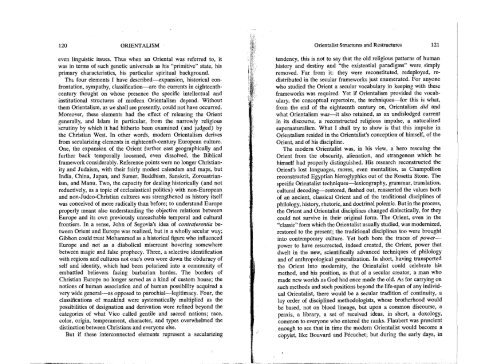Orientalism - autonomous learning
Orientalism - autonomous learning
Orientalism - autonomous learning
You also want an ePaper? Increase the reach of your titles
YUMPU automatically turns print PDFs into web optimized ePapers that Google loves.
120 ORIENTALISM<br />
Orientalist Structures and Restructures<br />
121<br />
even linguistic issues. Thus when an Oriental was referred to, it<br />
was in terms of such genetic universals as his "primitive" state, his<br />
primary characteristics, his particular spiritual background.<br />
The four elements I have described--expansion, historical confrontation,<br />
sympathy, classification-are the currents in eighteenthcentury<br />
thought on whose presence the specific intellectual and<br />
institutional structures of modern <strong>Orientalism</strong> depend. Without<br />
them <strong>Orientalism</strong>, as we shall see presently, could not have occurred.<br />
Moreover, these elements had the effect of releasing the Orient<br />
generally, and Islam in particular, from the narrowly religious<br />
scrutiny by which it had hitherto been examined (and judged) by<br />
the Christian West. In other words, modern <strong>Orientalism</strong> derives<br />
from secularizing elements in eighteenth-century European culture.<br />
One, the expansion of the Orient further east geographically and<br />
further back temporally loosened, even dissolved, the Biblical<br />
framework considerably. Reference points were no longer Christianity<br />
and Judaism, with their fairly modest calendars and maps, but<br />
India, China, Japan, and Sumer, Buddhism, Sanskrit, Zoroastrianism,<br />
and Manu. Two, the capacity for dealing historically (and not<br />
reductively, as a topic of ecclesiastical politics) with non-European<br />
and non-Judeo-Christian cultures was strengthened as history itself<br />
was conceived of more radically than before; to understand Europe<br />
properly meant also understanding the objective relations between<br />
Europe and its own previously unreachable temporal and cultural<br />
frontiers. In a sense, John of Segovia's idea of contraferentia between<br />
Orient and Europe was realized, but in a wholly secular way;<br />
Gibbon could treat Mohammed as a historical figure who influenced<br />
Europe and not as a diabolical miscreant hovering somewhere<br />
between magic and false prophecy. Three, a selective identification<br />
with regions and cultures not one's own wore down the obduracy of<br />
self and identity, which had been polarized into a community of<br />
embattled believers facing barbarian hordes. The borders of<br />
Christian Europe no longer served as a kind of custom house; the<br />
notions of human association and of human possibility acquired a<br />
very wide general-as opposed to parochial-legitimacy. Four, the<br />
classifications of mankind were systematically multiplied as the<br />
possibilities of designation and derivation were refined beyond the<br />
categories of what Vico called gentile and sacred nations; race,<br />
color, origin, temperament, character, and types overwhelmed the<br />
distinction between Christians and everyone else.<br />
But if these interconnected elements represent a secularizing<br />
tendency, this is not to say that the old religious patterns of human<br />
history and destiny and "the existential paradigms" were, simply<br />
removed. Far from it: they were reconstituted, redeployed, redistributed<br />
in the secular frameworks just enumerated. For anyone<br />
who studied the Orient a secular vocabulary in keeping with these<br />
frameworks was required. Yet if <strong>Orientalism</strong> provided the vocabulary,<br />
the conceptual repertoire, the techniques-for this is what,<br />
from the end of the eighteenth century on, <strong>Orientalism</strong> did and<br />
what <strong>Orientalism</strong> was-it also retained, as an undislodged current<br />
in its discourse, a reconstructed religious impulse, a naturalized<br />
supernaturalism. What I shall try to show is that this impulse in<br />
<strong>Orientalism</strong> resided in the Orientalist's conception of himself, of the<br />
Orient, i:lnd of his discipline.<br />
The modern Orientalist was, in his view, a hero rescuing the<br />
Orient from the obscurity, alienation, and strangeness which he<br />
himself had properly. distinguished. His research reconstructed the<br />
Orient's lost languages, mores, even mentalities, as Champollion<br />
reconstructed Egyptian hieroglyphics out of the Rosetta Stone. The<br />
specific Orientalist techniques-lexicography, grammar, translation,<br />
cultural decoding-restored, fleshed out, reasserted the values both<br />
of an ancient, classical Orient and of the traditional disciplines of<br />
philology, history, rhetoric, and doctrinal polemic. But in the process,<br />
the Orient and Orientalist disciplines changed dialectically, for they<br />
could not survive in their original form. The Orient, even in the<br />
"classic" form which the Orientalist usually studied, was modernized,<br />
restored to the present; the traditional disciplines too were brought<br />
into contemporary culture. Yet both bore the traces of powerpower<br />
to have resurrected, indeed created, the Orient, power that<br />
dwelt in the new, scientifically advanced techniques of philology<br />
and of anthropological generalization. In short, having transported<br />
the Orient into modernity, the Orientalist could celebrate his<br />
method, and his position, as that of a.secular creator, a man who<br />
made new worlds as God had once made the old. As for carrying on<br />
such methods and such positions beyond the life-span of any individual<br />
Orientalist, there would be a secular tradition of continuity, a<br />
lay order of disciplined methodologists, whose brotherhood would<br />
be based, not on blood lineage, but upon a common discourse, a<br />
praxis, a library, a set of received ideas, in short, a doxology,<br />
common to everyone who entered the ranks. Flaubert was prescient<br />
enough to see that in time the modern Orientalist would become a<br />
copyist, like Bouvard and Pecuchet; but during the early days, in
















